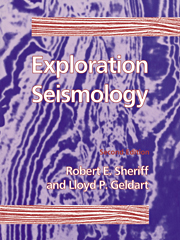Book contents
- Frontmatter
- Contents
- Preface
- Mathematical conventions and symbols
- 1 Introduction
- 2 Theory of seismic waves
- 3 Partitioning at an interface
- 4 Geometry of seismic waves
- 5 Seismic velocity
- 6 Characteristics of seismic events
- 7 Equipment
- 8 Reflection field methods
- 9 Data Processing
- 10 Geologic interpretation of reflection data
- 11 Refraction methods
- 12 3-D Methods
- 13 Specialized techniques
- 14 Specialized applications
- 15 Background mathematics
- Appendices
- Index
6 - Characteristics of seismic events
Published online by Cambridge University Press: 05 June 2012
- Frontmatter
- Contents
- Preface
- Mathematical conventions and symbols
- 1 Introduction
- 2 Theory of seismic waves
- 3 Partitioning at an interface
- 4 Geometry of seismic waves
- 5 Seismic velocity
- 6 Characteristics of seismic events
- 7 Equipment
- 8 Reflection field methods
- 9 Data Processing
- 10 Geologic interpretation of reflection data
- 11 Refraction methods
- 12 3-D Methods
- 13 Specialized techniques
- 14 Specialized applications
- 15 Background mathematics
- Appendices
- Index
Summary
Overview
The basic task of interpreting seismic records is that of selecting those events on the record that represent primary reflections (or refractions), translating the arrival times for these into depths and dips, and mapping the reflecting (refracting) horizons. In addition, the interpreter must be alert to events features such as changes in amplitude or character that may yield valuable information about other types of events, such as multiple reflections and diffractions. The characteristics of events are the subject of this chapter.
The features that allow one to recognize and identify an event – coherence, amplitude standout, character, dip, and normal moveout – are discussed in §6.1. Differences in arrival time because of offset provide an especially useful method of distinguishing between reflections, refractions, multiples, and other types of events.
Part of the downgoing wavetrain from a seismic source is reflected at each interface where the acoustic impedance changes. Synthetic seismograms showing the reflections expected from a model aid in understanding seismic reflections. The strongest reflections usually result from unconformities or significant changes in lithology, but reflections also occur from minor lithologic changes. Most reflections are the interference composites from a number of closely spaced interfaces. Occasional reflections are caused by impedance changes associated with phase changes or fluid contacts rather than bedding contacts. Reflections occur not only because of energy returned from the reflecting point, but because of energy returned from the entire Fresnel-zone area. Reflection amplitude, phase, and overall appearance change because of reflector curvature.
- Type
- Chapter
- Information
- Exploration Seismology , pp. 145 - 190Publisher: Cambridge University PressPrint publication year: 1995
- 1
- Cited by



